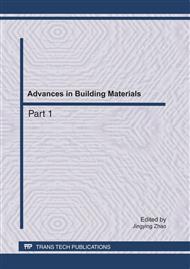p.197
p.202
p.208
p.212
p.217
p.223
p.228
p.233
p.238
Carbonation Depth of Recycled Aggregate Concrete Incorporating Fly Ash
Abstract:
This paper addresses the efficiency of using recycled concrete as an aggregate by systematically presenting results on the influence of fly ash on recycled aggregate concrete (RAC) properties. The percentage of recycled aggregate replacements of natural aggregate used by weight was 50%. Fly ash (FA) was used as 0, 10, 20, 30, and 40% by weight replacement of cement. The results showed that an increase in the W/B decreased the resistance to carbonation depth. Nevertheless, the use of FA as a substitute for cement decreased the carbonation depth of the recycled aggregate concrete. Being analyzed on the basis of Gray Theory, it can be seen that the biggest influence on the depth of carbonation of the recycled aggregate concrete comes from W/B, then the carbonation age and FA content affects the least.
Info:
Periodical:
Pages:
217-222
Citation:
Online since:
May 2011
Authors:
Price:
Сopyright:
© 2011 Trans Tech Publications Ltd. All Rights Reserved
Share:
Citation:


